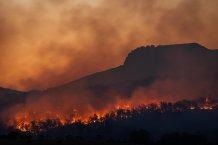A study led by the University of Exeter has revealed an underestimation of the complete magnitude of the impact of smoke from seasonal fires in Central Africa by certain climate models over the South-East Atlantic, specifically the potential climate warming caused by the black carbon component of the aerosol.
 Black carbon’s ability to absorb sunlight means it can play a pivotal role in heating the atmosphere. Image Credit: University of Exeter.
Black carbon’s ability to absorb sunlight means it can play a pivotal role in heating the atmosphere. Image Credit: University of Exeter.
The underestimations include certain climate models of the CMIP6 series employed to take the decisions for restricting global warming to 1.5 °C in the 2018 Paris Agreement.
The study was led by Dr. Marc Mallet from MeteoFrance in Toulouse. The research involved the use of satellite and ground-based remote sensing data backed up by aircraft measurements. The researchers identified the drawbacks in climate modeling in capturing the actual climate impact of biomass-burning aerosols that are dissipated over the South-East Atlantic.
The United Kingdom’s contribution to the project was led by Professor Jim Haywood from the University of Exeter. Professor Haywood contributed to the project by assisting the measurement campaign and was an important partner in the modeling led by Dr. Mallet.
The research was published in the journal Science Advances on October 8th, 2021.
Black carbon aerosols are microscopic particulates suspended in the air. Man-made and natural fires are the key cause for the generation of black carbon aerosols that tend to absorb a notable amount of sunlight.
The potential of black carbon to absorb black carbon implies that it can serve an important role in heating the atmosphere and seriously contributing to the impacts of climate change at regional and continental levels.
The research team, comprising scientists from CNRM, the University of Lille and the UK Met Office, made a comparison on the ways in which the CMIP6 models represented several critical variables. This includes low-level stratocumulus clouds, smoke aerosols and solar absorption, using innovative and recent space-based remote-sensing observations supported by aircraft observations.
The observations uncovered that the biomass burning aerosols result in an increased amount of sunlight absorption over the South-East Atlantic. This would lead to a warmer climate system, which was misinterpreted by many models, stating incorrectly that it led to a cooling effect.
The study is the culmination of several years of international efforts studying the smoke aerosol over the South-East Atlantic from seasonal fires over Africa with satellite, surface-based and on-site sampling.
The project also included various operations such as the United Kingdom’s heavily equipped FAAM research aircraft in August and September 2017, when the aircraft was based in Ascension Island in the middle of the Atlantic ocean, and the US-led ORACLES and LASIC programs and the French-led AEROCLO-Sa project.
The results from the study are quite conclusive. Despite decades of research, the climatic impacts of aerosols are still inadequately modelled by our climate models, which leads to significant uncertainties in future climate projections.
Jim Haywood, Professor, Atmospheric Science, University of Exeter
Haywood led the detachment to Ascension Island and is a Research Fellow at the Met Office Hadley Centre.
The heating from black carbon aerosol also has unique impacts on clouds and regional rainfall patterns, making it an important process to understand and capture in climate simulations. The Met Office and University of Exeter work closely on these issues together with other academic partners in the UK and wider international community, to better understand the role of aerosols in past and future climate change.
Dr. Ben Johnson, Met Office Hadley Centre
Journal Reference:
Mallet, M., et al. (2021) Climate models generally underrepresent the warming by Central Africa biomass-burning aerosols over the Southeast Atlantic. Science Advances. doi.org/10.1126/sciadv.abg9998.